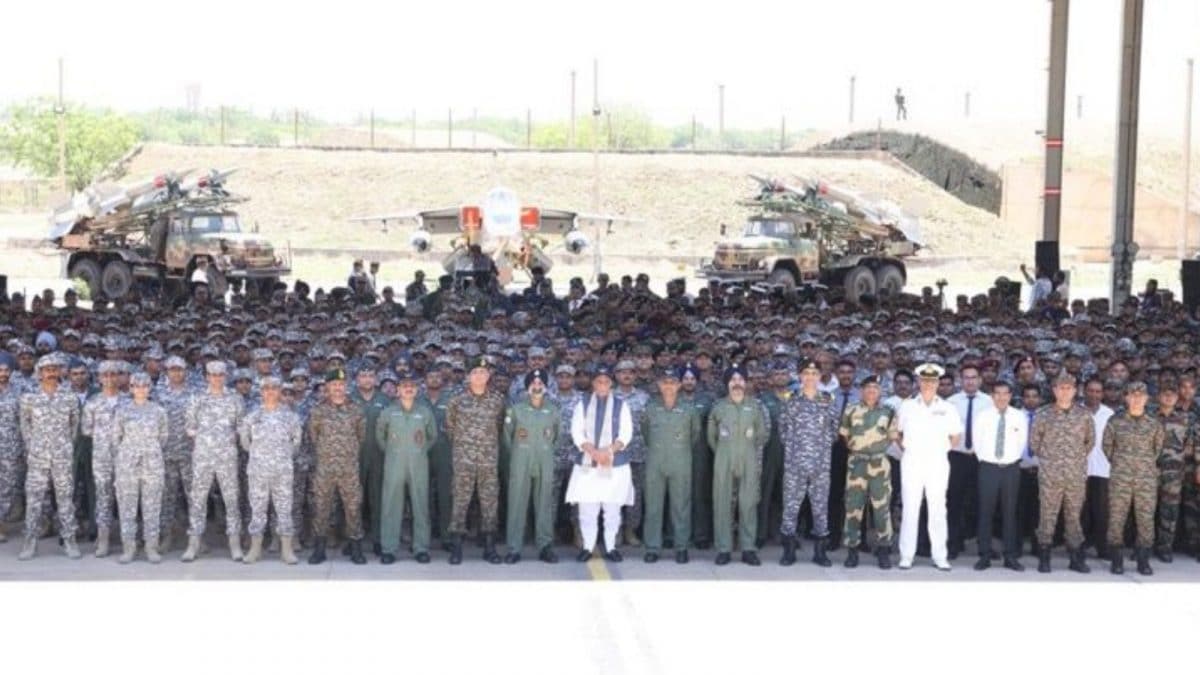 |
|
The visit of Defence Minister Rajnath Singh to the Air Force Station in Bhuj, Gujarat, on Friday, May 16, 2025, carries significant weight, both domestically and internationally. Following in the footsteps of Prime Minister Narendra Modi's recent address at Adampur airbase, where the S-400 air defense system was prominently featured, Singh's deliberate choice to pose with air warriors against the backdrop of Pechora missiles and Jaguar fighter aircraft sends a clear message of India's military preparedness and resolve. This carefully orchestrated image, disseminated through media channels, is intended to project an image of strength and deterrence, particularly in the context of regional security concerns. The strategic location of Bhuj, situated near the border with Pakistan, further amplifies the significance of this visual communication. The inclusion of both the Pechora missile system, a surface-to-air defense system designed to intercept aerial threats, and the Jaguar fighter aircraft, a capable ground attack and reconnaissance platform, showcases India's multifaceted defense capabilities. The selection of these specific weapon systems is not accidental; it reflects a calculated effort to highlight India's ability to defend its airspace and project power within the region. Furthermore, Singh's address to the air warriors at Bhuj serves as a morale booster, reinforcing their commitment to national security and assuring them of the government's unwavering support. By directly engaging with the personnel responsible for maintaining and operating these critical defense assets, Singh reinforces the importance of their role in safeguarding India's sovereignty. This interaction also provides an opportunity for him to gain firsthand insights into the operational challenges and needs of the air force, enabling more informed decision-making at the policy level. The combination of a strategically chosen backdrop and a direct address to the troops underscores the government's commitment to bolstering India's defense capabilities and projecting an image of strength and determination.
Beyond the immediate visual impact, Rajnath Singh's statement regarding 'Operation Sindoor' adds another layer of complexity to the narrative. His assertion that the operation is 'not over yet' and that the 'full picture' will be revealed 'when the right time comes' is deliberately ambiguous, leaving room for speculation and interpretation. This ambiguity serves multiple purposes. Firstly, it maintains an element of strategic uncertainty, keeping potential adversaries guessing about India's future actions. Secondly, it allows the government to retain flexibility in its response to evolving security challenges. Thirdly, it reinforces the notion that India is prepared to take decisive action when necessary to protect its national interests. The reference to 'Operation Sindoor' without providing specific details also allows the government to control the narrative, shaping public perception of India's security posture. This control is crucial in maintaining public confidence and garnering support for defense policies. The timing of Singh's statement, following his visit to Srinagar, further underscores the government's focus on security issues in the region. By linking the situation in Kashmir with broader regional security concerns, the government aims to present a unified and consistent message about its commitment to protecting India's territorial integrity and combating terrorism. The reference to 'Operation Sindoor' could also be interpreted as a signal to domestic audiences, reinforcing the government's image as a strong and decisive leader capable of safeguarding the nation's interests. In a political landscape increasingly shaped by security concerns, this image can be a valuable asset. However, it is important to note that such statements also carry the risk of escalating tensions and provoking unintended consequences. The ambiguous nature of the message requires careful management to avoid misinterpretations and ensure that it serves the intended purpose of deterrence and reassurance.
The Defence Minister's expression of concern regarding the International Monetary Fund's (IMF) second payment of USD 1.023 billion to Pakistan under the Extended Fund Facility program is a direct indictment of Pakistan’s alleged support of terrorism and a strategic effort to isolate Pakistan financially and diplomatically. This statement represents a significant escalation in India's rhetoric towards its neighbor and highlights the deep-seated mistrust between the two nations. Singh's assertion that Pakistan will use the funds to 'support terrorism' is a serious accusation that could have far-reaching consequences for Pakistan's international relations. By directly linking the IMF's financial assistance to Pakistan with the issue of terrorism, Singh is attempting to influence the IMF's future decisions regarding financial assistance to Pakistan. This is part of a broader strategy to pressure Pakistan to take concrete steps to dismantle terrorist infrastructure and cease its support for terrorist groups operating in the region. The accusation also aims to rally international support for India's position and to isolate Pakistan on the global stage. By publicly expressing his concerns, Singh is putting pressure on the international community to scrutinize Pakistan's use of these funds and to hold it accountable for any violations of international norms and commitments. The statement also serves as a reminder to the international community that Pakistan's actions continue to pose a threat to regional and global security. The linkage with the IMF funding introduces economic considerations into the already complex geopolitical dynamic. The implication is that economic assistance to Pakistan is, in effect, enabling terrorism, a powerful argument designed to influence international policy. This strategy aligns with India's longstanding efforts to highlight Pakistan's alleged role in sponsoring terrorism and to secure international support for its efforts to combat terrorism. The statement underscores the challenges facing the international community in addressing the complex relationship between development assistance, security concerns, and state-sponsored terrorism. India's stance demonstrates a willingness to openly challenge international institutions and to advocate for a more stringent approach to dealing with states accused of supporting terrorism.
Source: Pechora Missile System, Jaguar Jet Feature In Rajnath Singh's Bhuj Airbase Photo With Air Warriors
